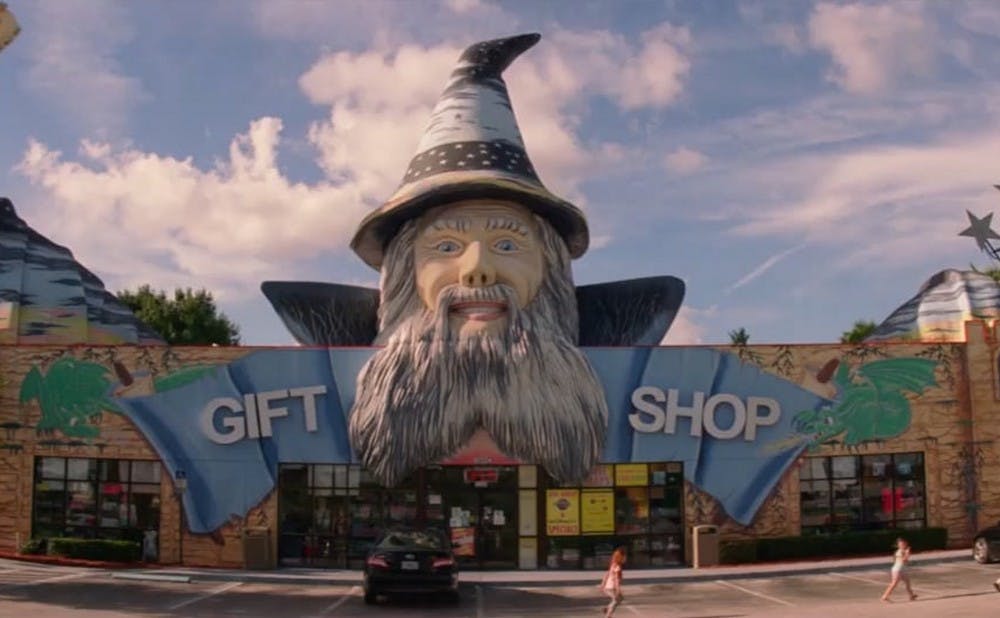Summers in Kissimmee, Fla. — a city just south of Orlando and the setting of Sean Baker’s “The Florida Project” — are hot. Anything that comes into contact with the sun melts or glistens or burns under its unrelenting rays. Ice cream, though sweeter in the thick heat, has to be eaten quickly before it drips and splats onto the blistering pavement. The whirring hum of fans fills every indoor space and the dark tint of sweat stains are unavoidable. But for Moonee (played by Brooklynn Prince), the precocious six-year-old around whom “The Florida Project” centers, none of those caveats really matter. Summer means that school’s out and unsupervised adventure awaits, and she’s determined to create as much magic and mischief in her corner of the universe as she can.
While Moonee’s taste for troublemaking is no different than any other child’s, her life is far from typical: her home is a purple motel called the Magic Castle, an establishment marked by transience and poverty — it’s a place for people at a crossroads, economically self-sufficient enough to make rent every week but desperate for the ability to afford something better. Moonee’s mom Halley (Bria Vinaite), a tattooed 20-something-year-old with bright blue hair and an aura of carelessness, struggles to make ends meet for herself and her daughter. She peddles overpriced perfume to wealthy resort-goers and relies on the kindness of her neighbors to get by. We’re fiercely aware that the motel’s moniker is cruelly tongue-in-cheek — Moonee and her friends play in the shadows of Disney World and its Magic Kingdom, though they will never step foot inside its fortified gates.
And yet it’s clear that Moonee isn’t particularly bothered by this. Indeed, she’s learned how to make the most of what she has, as precarious and broken as it might be. “The guy who lives here gets arrested a lot,” Moonee mentions to her friends Scooty (Christopher Rivera) and Jancey (Valeria Cotto) as they walk across the balcony of the Magic Castle. “These are the rooms we’re not supposed to go in. But let’s go anyway!” Moonee’s kingdom reaches as far as her eye can see, from her motel to the dilapidated buildings littering Kissimmee, and she reigns supreme — even Bobby (Willem Dafoe), the beleaguered manager of the Magic Castle, can barely keep her from burning the place down.
She soars from antic to antic without reservation, conning tourists out of money for ice cream (“Could you give us some change, please? The doctor said we have asthma and we have to eat ice-cream right away”) and impishly spitting on cars. As off-colored and unconventional as Moonee’s pursuits might seem to spectators, they’re the hallmarks of her Florida summers unburdened by the woes of reality, as numbered as they might be.
This preservation of childhood innocence — and the strife and struggles of adulthood which encircle it — defines almost every scene of “The Florida Project.” While Moonee schemes and plays, poverty and danger and uncertainty loom over her. Halley, often as childish and unrelenting as her daughter, doesn’t know how to cope with the burdens wrought by adulthood; though she has rent to pay and mouths to feed, she still yearns to escape, indulging in any delights she encounters and evading responsibilities. Bobby struggles to keep the Magic Castle afloat and strike the right balance between benevolence and authority — he cares deeply for his residents and their needs, but his thoughtfulness becomes self-defeating when he receives so little in return. And though no one looks after Moonee or protects her as fiercely as he does, Bobby ultimately has little say in how she’s raised or where she ends up — a fact that is as disheartening as it is realistic.
At the core of “The Florida Project” is that thin, precarious line between dreams and reality. Sean Baker’s richly saturated 35mm cinematography and shallow, melty depths of field create a beautiful juxtaposition between Moonee’s vibrant perception of her world and its harsher realities (a welcome departure from the iPhone direction that defined Baker’s previous film, “Tangerine”). Moreover, Baker’s film never passes judgement on its characters, but warmly embraces them for all of their shortcomings and imperfections — their flaws are what make them so singular, so heartbreakingly real — and he makes a concerted effort not to create a monolith out of his subject matter, presenting an unvarnished and authentic portrayal of poverty. And though “The Florida Project” is honest about the limitations of dreaming, ending on a heartbreakingly genuine note, it’s hopeful until its end. Innocence may not last forever, but its confidence in something greater certainly does.
Get The Chronicle straight to your inbox
Signup for our weekly newsletter. Cancel at any time.

